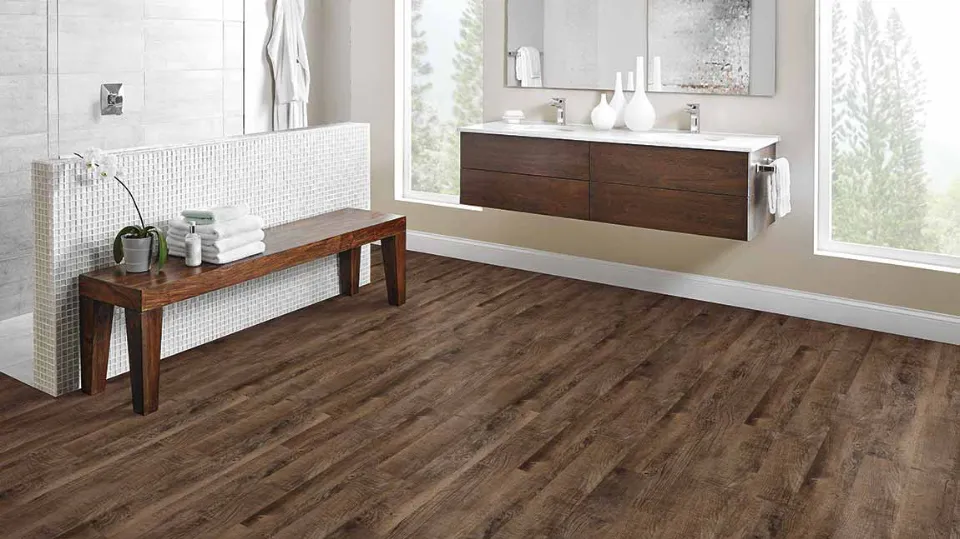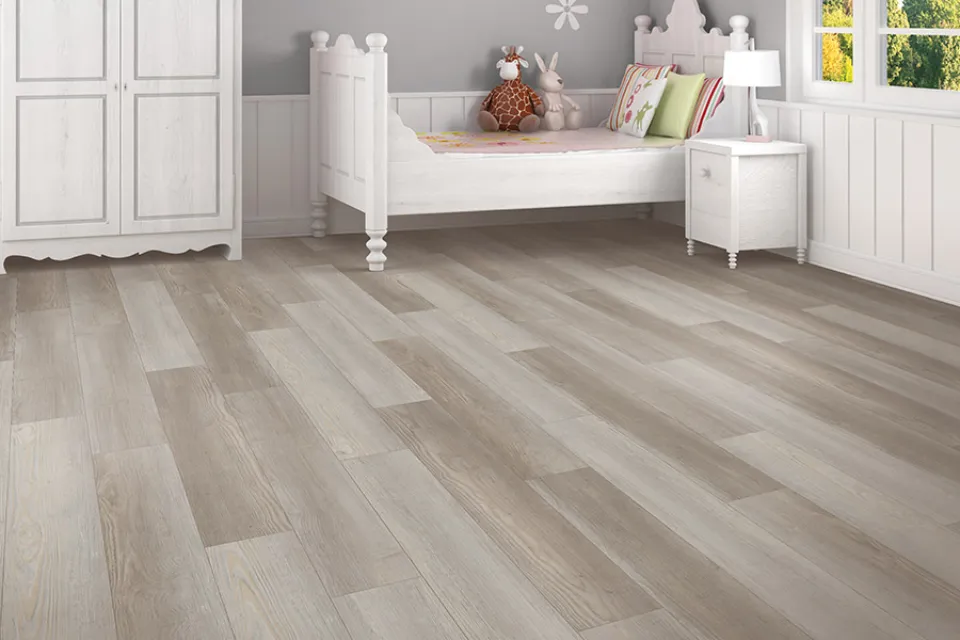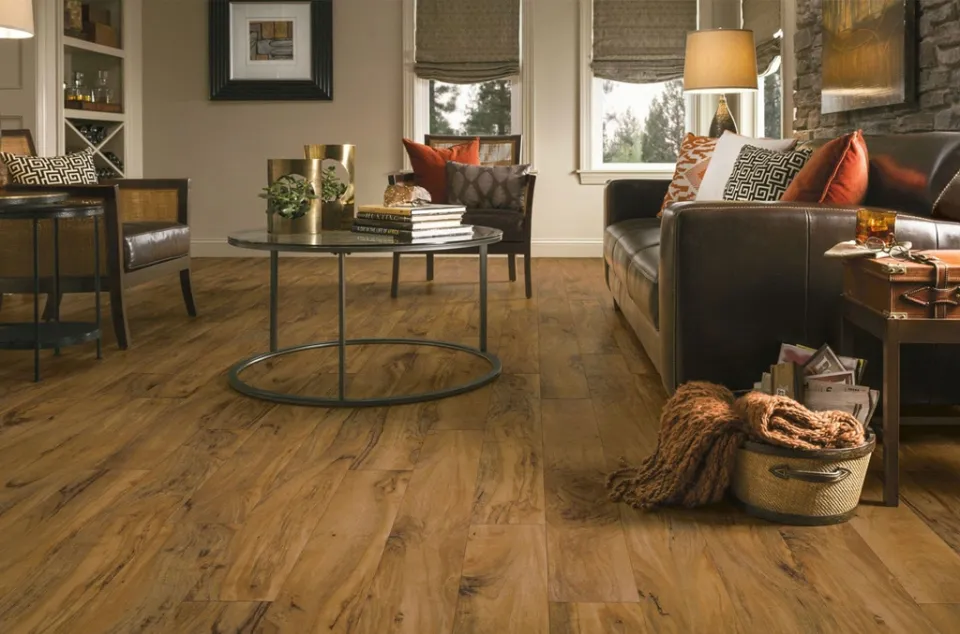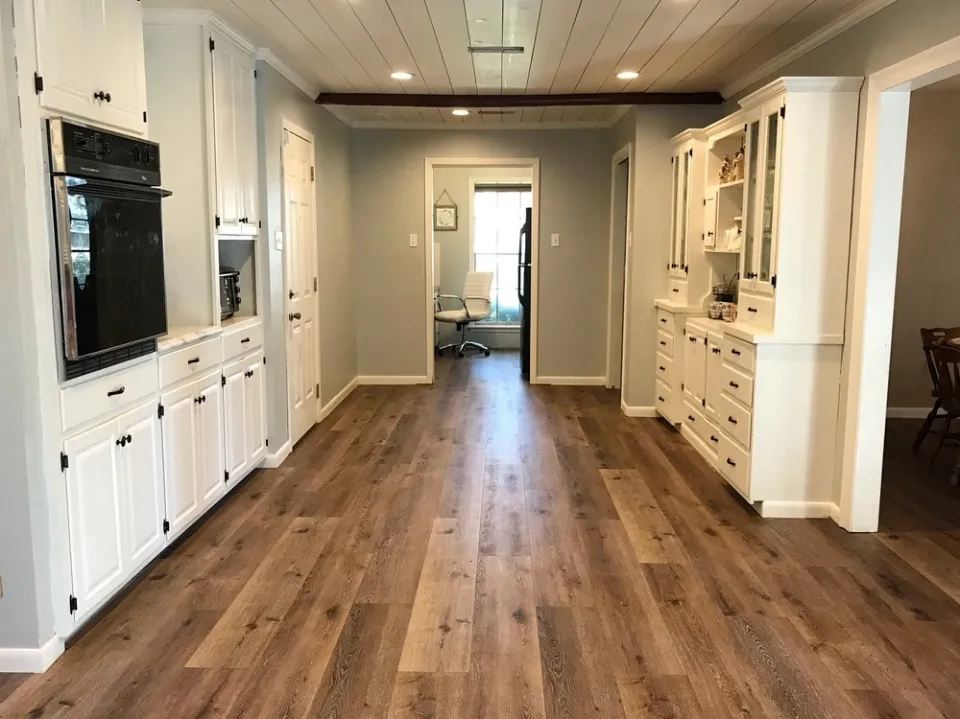To begin with, what is LVP flooring? Visit the sections below to learn more about the main characteristics, advantages, and contrasts of luxury vinyl plank flooring.
Luxury Vinyl Plank, or LVP, is a long-lasting, attractive, and reasonably priced substitute for hardwood flooring. It works well for a variety of residential and commercial projects, and when installed properly, it perfectly replicates the warmth, texture, and appearance of real wood.
Please read on for more detailed information.
What is Luxury Vinyl Plank Flooring?
LVP is shorthand for Luxury Vinyl Plank. LVP covers all vinyl designed in planks, giving the appearance of wood floors with all the features and advantages of vinyl. You may occasionally hear people use the term “LVT,” which stands for Luxury Vinyl Tile. LVT encompasses all vinyl products designed to mimic tile or stone. LVP, on the other hand, is typically the more widespread and frequently used acronym. For the purposes of this piece, let’s use “LVP” as the catch-all term, as it’s becoming in the flooring industry.
While vinyl plank is the same as LVP, it is not the same as vinyl. Confused yet? Let’s go a little deeper on LVP.
LVP is a composite product made of several layers that combine to form durable, low-maintenance flooring. The bottom layer is a “backer board” – a flexible base made of PVC for stability. The central core is what makes most LVP “water-resistant” rather than “waterproof”, as the central core layer is often not fully waterproof, however, it does provide the strength for the flooring. On top of the core is the “vinyl layer” which is printed with the pattern and color – traditionally mimicking wood or stone. The most important layer—the wear layer—comes last.
The wear layer is a thin, clear protective layer that makes the flooring scratch- and stain-resistant. Usage is typically determined by wear layer thickness, with thinner wear layer planks being used in residential applications and thicker wear layer planks being used in commercial settings. Wear layer thickness varies from 6 mil on the thin end, and 30 mil on the high end. 12 mil up to 20 mil thickness are standard commercial wear layers; under 12 are rated for light commercial and residential use.
LVP is a more flexible vinyl product than some of the other vinyl products on the market, but it is also stronger because it is glue-down flooring, which is permanently adhered with adhesive to the subfloor. Unlike their Rigid Core equivalents, these planks do not interlock or float.

Pros and Cons of Luxury Vinyl Plank Flooring
Before deciding on luxury vinyl plank flooring for your home, it’s crucial to fully comprehend its benefits and drawbacks.
LVP Pros:
- It’s Cheap! (ok, relatively speaking)
LVP is a cost-effective way to make a big impact in your space, it’s significantly cheaper than traditional hardwood and can offer a similar look and incredible durability for your budget
- It’s Got That Style
LVP has near-infinite options for looks mimicking other materials like wood and stone and can add splashes of color or patterns/grains to match any décor
- It’s Versatile To A Point!
LVP is more resistant to water than even laminate flooring. So, it can be installed in high traffic areas where you don’t have to worry about those spills or pet accidents immediately
- It’s Tuff E’Nuff!
LVP is resilient (remember those wear layers?!) scuff, dent and scratch resistant and can take the traffic of active households.
But nothing’s perfect. Let’s examine LVP’s disadvantages.

LVP Cons:
- Installation Sometimes Stinks
While your flooring professional at The Good Guys will make this easy for you, LVP installation commonly requires glue. And gluing the flooring to the subfloor can take some time and leave some odor while the glue dries. As a result, future replacements might be a little more challenging because the glue might eventually become more difficult to remove. LVP is easier to replace a damaged slat than WPC or SPC flooring, though. These planks do not interlock, so it is fairly easy to remove and replace one. With WPC or SPC flooring, you would need to back the floor out to the damaged area, replace the one damaged plank, and then refit the remaining floor.
- Do You Feel Happy When the Sun Shines on Your Floors?
Some LVP that is less expensive has wear layers that are thinner and have less UV resistance. If your room receives a lot of natural light, over time, this may cause fading in exposed areas. The furniture needs to be rearranged. Your visitors will be able to tell where that chaise lounge and shag rug once were if you have faded areas. Your Good Guys professional will assist you with this once more, but if your home enjoys a lot of natural light, you might want to think about it.
Luxury, You Has It? – Let’s be real
LVP has never been and will never be hardwood. That is not a bad thing, but many buyers see it as such, so if you’re planning on selling your home, vinyl plank won’t get you the same return as solid hardwood. Unlike many hardwood floors, LVP cannot be refinished.

Luxury Vinyl Plank Flooring Vs. Laminate Flooring
It’s common to wonder what distinguishes luxury vinyl plank flooring from conventional laminate flooring when choosing the floors for your home. Despite having a similar appearance and installation process, laminate is not entirely synthetic, in contrast to LVP, as its core is made of real wood byproducts that have been resin-bonded.
LVP is more waterproof than laminate, which makes it an excellent option for spaces like kitchens, bathrooms, mudrooms, and laundry rooms. This is one of the main reasons to choose LVP over laminate.
Additionally, LVP is typically simpler to install and maintain than laminate. You can safely use any cleaning method on LVP that you prefer including sweeping, dry brooming, or even wet mopping. Both types of flooring can be installed using similar methods, but LVP can be cut with a utility knife and laminate needs a power saw.
Many people also agree that while both seek to appear as hardwoods, LVP more convincingly mimics hardwood flooring than laminate floors.
Although early versions of LVP lacked the texture that laminate flooring can offer, modern LVP is available in a wide range of hues and textures.

FAQs
What is the Difference Between LVP and Vinyl Plank?
Luxury vinyl flooring comes in two varieties: LVT (Luxury Vinyl Tile) and LVP (Luxury Vinyl Plank). LVT is vinyl flooring designed in a tile shape, whereas LVP is vinyl flooring designed in planks to resemble traditional hardwood floor planks.
Is LVP Better Than Hardwood?
If properly taken care of, hardwood can last a lifetime. It’s very scratch resistant, more so than LVP, and repels water much better than it’s given credit for. The only thing that will actually seriously harm hardwood, if it is built properly, is a flood.
Is LVP Really Waterproof?
Thus, luxury vinyl plank flooring is waterproof, but not flood-proof. Vinyl plank flooring differs from options for laminate and hardwood because of its waterproof feature.
How Long Does LVP Last?
LVP flooring’s lifespan is significantly influenced by the flooring’s thickness and durability. If installed correctly and maintained appropriately, the flooring can last from 10-20 years depending on location and the thickness installed.
Is LVP Cheaper Than Tile?
Vinyl plank is much more budget-friendly than ceramic tile. Ceramic tiles can be as expensive as hardwood floors or high-end carpet, depending on the type you choose. Including labor costs, installing vinyl plank is 40% less expensive than installing ceramic tile.
Summary: What is LVP Flooring?
What is LVP Flooring? Luxury vinyl is a specific type of vinyl flooring. The realistic natural materials that luxury vinyl floors can now imitate were not previously available in sheet form, which limited the availability of older vinyl flooring. Modern LVT and LVP floors are now available in a vast array of patterns and colors and are created to closely resemble natural materials like wood, stone, and tile. Even some LVT and LVP flooring options have textures that make them resemble these materials. The planks and tiles can be found in both narrow and wide styles, and many LVT and LVP floors even have seams for grout.
If you have any questions, please leave a comment. My Prime Home tries to give you the best home improvement information. Don’t forget to share the post. Thank you for reading.
Read about



